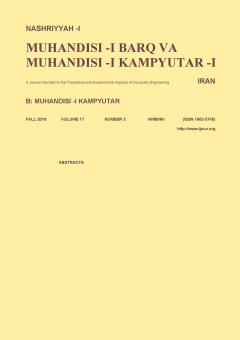SDDNA: Sign-Digit Coding for Mapping Digital Data in DNA Data Storage
Subject Areas : electrical and computer engineeringمیثم اللهی رودپشتی 1 , S. Alinezhad 2
1 -
2 -
Keywords: DNA data storagebiological storage systemcodingmapping algorithmsign-digit,
Abstract :
Due to the explosive increment of data in recent application, available data storage cannot respond to this volume of data, for this reason molecular memory have been suggested in recent research. DNA is molecular data storage that can store a large amount of data in a limited space with high endurance. Storing data in low volumes can be provided using appropriate mapping. In this paper, a new method for mapping digital data to DNA have been proposed with the aim of simple coding, omitting the decoding faults, increasing the speed of coding and storing digital data and sign-digit with sufficient compression. Studies show that the proposed method can guarantee long-term retrieval of information from DNA compared to previous methods. It also uses less compression to store digital data as compared to the previous methods.
[1] Data storage supply and demand worldwide, from 2009 to 2020, Available at: https://www.statista.com/statistics/751749/worldwide-data-storage-capacity-and-demand, 2018.
[2] Where in the world is storage? Available at: https://www.idc.com/downloads/where_is_storage_infographic_243338.pdf, 2013.
[3] Sony develops magnetic tape technology with the world’s highest recording, 2014. Available at: www.sony.net/SonyInf/News/Press/201708/17-070E/index.html.
[4] ExtremeTech. New optical laser can increase DVD storage up to one petabyte, Available at: https://www.extremetech.com/computing/ 159245-new-optical-laser-can-increase-dvd-storage-up-to-one-petabyte
[5] Sh. Pep, Storing Your Data on DNA? Sept. 2018, Available: https://www.capconnect.com.au/single-post/DNA-Storage.
[6] J. Bornholt, R. Lopez, L. Ceze, G. Seelig, and K. Strauss, "A DNA-based archival storage system," in Proc. of the 21st Int. Conf. on Architectural Support for Programming Languages and Operating Systems, ASPLOS’16, pp. 637-649, Atlanta, GA, USA, 2-6 Apr. 2016.
[7] A. Garg and M. Choudhary, "Analysing and obtaining the most efficient DNA computing algorithm," J. of Computational Intelligence in Bioinformatics, vol. 8, no. 1, pp. 1-6, Jun. 2015.
[8] D. Limbachiya and M. Kumar Gupta, "Natural data storage: a review on sending information from now to then via nature," ACM J. on Emerging Technologies in Computing Systems, vol. 18, no. 1, pp. 550-4832, May 2015.
[9] L. Organick, S. Dumas Ang, and Y. J. Chen, "Random access in large-scale DNA data storage," Nature Biotechnology, vol. 12, no. 1, pp. 242-248, Feb. 2018.
[10] E. Willerslev, A 700.000 year old horse gets its genome sequenced, https://news.ku.dk/all_news/2013/2013.6/a-700.000-year-old-horse-gets-its-genome-sequenced, 2013.
[11] B. Alberts, et al., Essential Cell Biology, Essential Cell Biology, Garland Science, 3rd Edition, 2009.
[12] Harvard cracks DNA storage, crams 700 terabytes of data into a single gram. https://www.extremetech.com/extreme/ 134672-harvard-cracks-dna-storage-crams-700-terabytes-of-data-into-a-single-gram.
[13] R. Heckel, "An archive written in DNA," Nature Biotechnology, vol. 36, no. 3, pp. 236-237, Mar. 2018.
[14] N. Goldman, P. Bertone, S. Chen, C. Dessimoz, E. M. LeProust, B. Sipos, and E. Birney, "Towards practical, high-capacity, low-maintenance information storage in synthesized DNA," Nature Biotechnology, vol. 494, no. 7435, pp. 77-80, Jan. 2013.
[15] D. Huffman, "A method for the construction of minimum-redundancy codes," in Proc. of the IRE, vol. 40, no. 9, pp. 1098-1101, Sept. 1952.
[16] G. M. Church, Y. Gao, and S. Kosuri, "Next-generation digital information storage in DNA," Science 337, 1628 2012.
[17] R. Grass, R. Heckel, M. Puddu, D. Paunescu, and W. Stark, "Robust chemical preservation of digital information on DNA in silica with error-correcting codes," Angewandte Chemie International Edition, vol. 54, no. 8, pp. 2552-2555, Feb. 2015.
[18] M. Blawat, et al., "Forward error correction for DNA data storage," Procedia Computer Science, vol. 80, Issue: C, pp. 1011-1022, Jun. 2016.
[19] Y. Erlich and D. Zielinski, "DNA fountain enables a robust and efficient storage architecture," Science, vol. 355, no. 6328, pp. 950-954, Mar. 2017.
[20] S. Yazdi, R. Gabrys, and O. Milenkovic, "Portable and error-free DNA-based data storage," Scientific Reports, vol. 7, no. 1, Article No. 5011, Jul. 2017.
[21] A. Chandrasekaran, O. Levchenko, D. Patel, M. MacIsaac, and K. Halvorsen, "Addressable configurations of DNA nanostructures for rewritable memory," Nucleic Acids Research, vol. 45, no. 19, pp. 11459-11465, Jul. 2017.
[22] B. Wang, Y. Xie, S. Zhou, X. Zheng, and C. Zhou, "Correcting errors in image encryption based on DNA coding," Molecules, vol. 23, no. 8, p. 1878, Aug. 2018.
[23] H. Lee, R. Kalhor, N. Goela, J. Bolot, and G. Church, "Terminator-free template-independent enzymatic DNA synthesis for digital information storage," Nature Communications, vol. 10, no. 1, p. 2283, Jun. 2019.
[24] I. Koren, Computer Arithmetic Algorithms, 2nd Edition, Published by A. K. Peters, Natick, MA, 2002.
[25] DNA Replication and Causes of Mutation, Available at: .https://www.nature.com/scitable/topicpage/dna-replicationand-causes-of-mutation-409.


